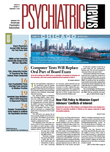Expecting preferential treatment, getting into power struggles, and having an exaggerated sense of self-importance seem to be three of the most defining characteristics of persons with narcissistic personality disorder, according to a new study. The other two are being angry and hostile and being critical of others.
The study was headed by Drew Westen, Ph.D., a professor of psychology at Emory University. Results were posted on AJP in Advance on August 15. (It will appear in the print edition of the American Journal of Psychiatry in November.)
The study appears to be noteworthy for several reasons. Narcissists have traditionally received short shrift from personality-disorder researchers, so this study may be a welcome addition to the sparse scientific literature about them, Westen and his colleagues noted. The study is also unusual in that its data came from observations of narcissists by clinicians in their own practices, not from narcissists' responses to structured interviews, which often have been found to be biased.
As such, Westen and his team have come up with what they describe as“ an empirically valid and clinically rich portrait of narcissistic personality disorder ... as seen in clinical practice in North America.”
Psychiatrists, Psychologists Participated
A random national sample of psychiatrists selected from the membership register of APA and a random national sample of psychologists—1,201 in all—participated in the study. Each participating psychiatrist or psychologist was asked to use three yardsticks to provide a detailed psychological description of “an adult patient you are currently treating or evaluating who has enduring patterns of thoughts, feeling, motivation, or behavior—that is, personality patterns—that cause distress or dysfunction.”
The yardsticks included the Axis II Criterion Checklist, the PD Construct Ratings, and the Shedler-Westen Assessment Procedure-II (SWAP-II), designed by two of the study's authors—Westen and Jonathan Shedler, Ph.D., of the University of Colorado Health Sciences Center.
The Axis II Criterion Checklist consists of randomly ordered criteria for DSM-IV Axis II disorders. A clinician is asked to check which criteria a patient meets. The PD Construct Ratings asks a clinician to rate, on a scale of 1 to 5, the extent to which a patient resembles or matches each DSM-IV personality-disorder construct. The SWAP-II consists of 200 personality-descriptive statements, each of which may describe a given patient well, somewhat, or not at all. A clinician is asked to rate a patient on each statement, using a scale of 0 to 7.
The researchers then used the results obtained with the Axis II Criterion Checklist and PD Construct Ratings to determine which of the 1,201 patients assessed by the 1,201 clinicians had narcissistic personality disorder. Out of the 1,201 patients, 255 were found to have the disorder according to the Axis II Criterion Checklist; 122 were similarly identified according to the PD Construct Ratings, and 101 according to both tests. Altogether, 377 of the 1,201 patients—almost a third—were found to have the disorder according to one or both yardsticks.
The researchers then analyzed the SWAP-II scores of these 377 subjects to identify features that best characterize narcissistic personality disorder. As noted above, five are especially prominent—having an exaggerated sense of self-importance, expecting preferential treatment, being angry and hostile, being critical of others, and getting into power struggles. Moreover, they analyzed the SWAP-II scores to identify features that are specific to the disorder but not necessarily characteristic of the average person with the disorder. One such feature is “seems to treat others primarily as an audience to witness own importance, brilliance, beauty, etc.” Another is“ tends to believe that he (she) can only be appreciated by, or should only associate with, people who are high status or special.”
Three Types of Narcissists
Finally, the researchers analyzed subjects' SWAP-II scores to see whether there are any subtypes of narcissistic personalities. They found three. The first is the high-functioning/exhibitionist narcissist. He (or she) has an exaggerated sense of self-importance, but is also articulate, energetic, outgoing, and achievement oriented. The second is the fragile narcissist. He (or she) wants to feel important and privileged to ward off painful feelings of inadequacy and loneliness. The third is the grandiose/malignant narcissist. He (or she) has an exaggerated sense of self-importance, feels privileged, exploits others, and lusts after power.
Although data are not yet available to demonstrate how these three subtypes should be treated clinically, the researchers offer some speculations in this regard. For instance, “High-functioning narcissists might benefit from an interpretive, insight-oriented approach (e.g., increased awareness of how narcissistic defenses erode possibilities for more meaningful attachments).... Fragile narcissists may respond best to empathic understanding and interventions that acknowledge underlying pain, insecurity, and vulnerability.... Grandiose/malignant narcissists are likely to have the poorest prognosis. They do not experience the kind of emotional pain that would motivate them to work in psychotherapy and would likely seek to manipulate the clinician or establish a 'one-up' position.”
All told, “The findings provide a richer and more-refined view of narcissistic personality than currently offered by the DSM,” Westen and his colleagues concluded in their study report. For example,“ Patients with narcissistic personality disorder appear more hostile, critical, and power-oriented than DSM-IV would lead us to expect.”
The study was funded by the National Institute of Mental Health.

